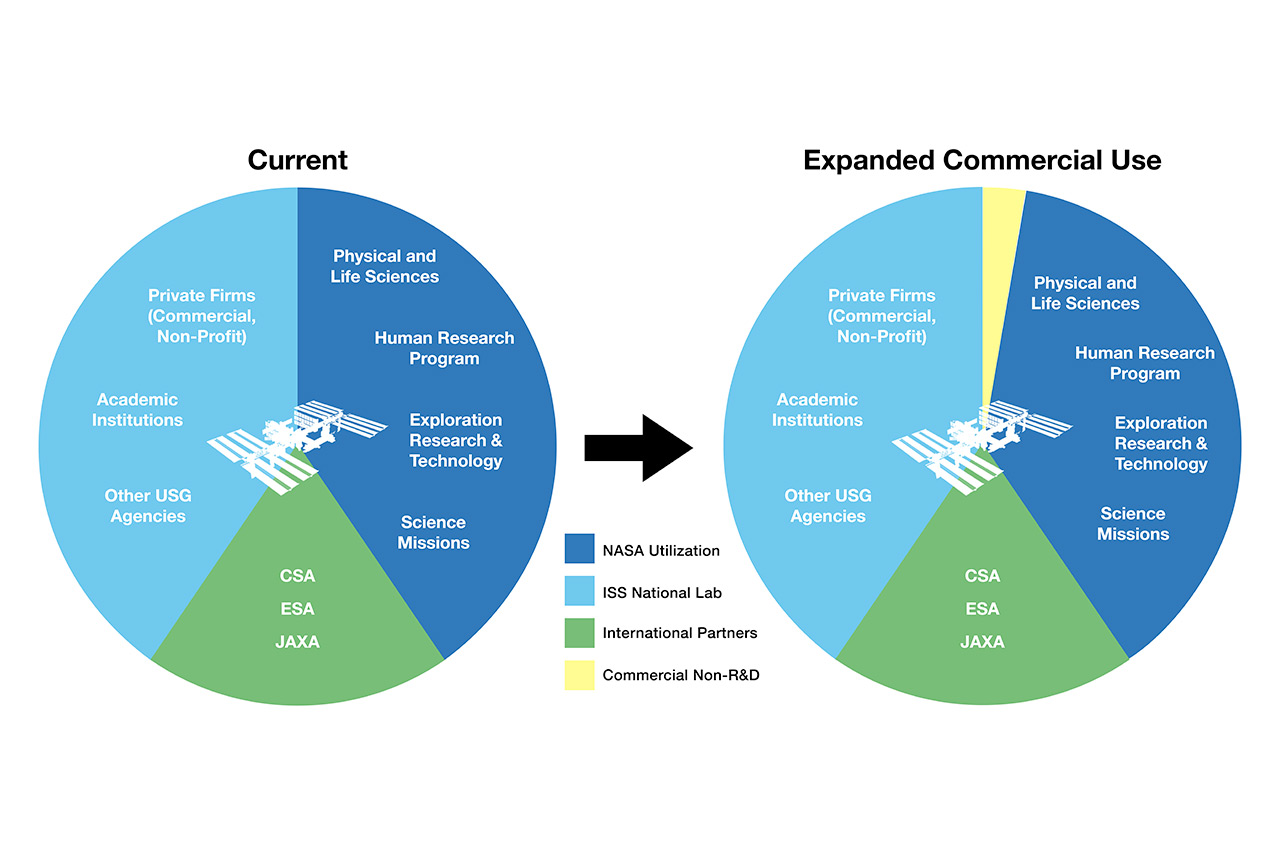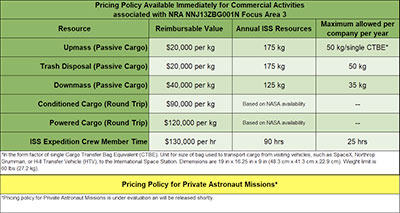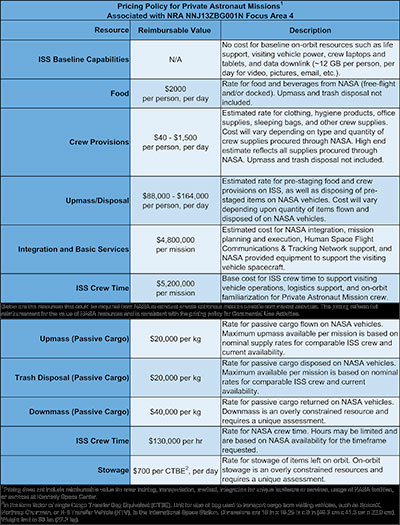|
|

|
|
Author
|
Topic: NASA: Station open to commercial activities
|
Robert Pearlman
Editor Posts: 49063
From: Houston, TX
Registered: Nov 1999
|
 posted 06-07-2019 01:45 PM
posted 06-07-2019 01:45 PM
   
collectSPACE NASA opens space station to for-profit activities, private astronautsNASA is extending its support on board the International Space Station to include new commercial activities, including hosting private astronauts, in an effort to eventually turn over low Earth orbit operations to private industry. The space agency on Friday (June 7) rolled out its five-part plan for fostering a low Earth orbit economy at the Nasdaq MarketSite in New York City. "NASA is opening the International Space Station to commercial opportunities and marketing these opportunities like we have never done before," said Jeff DeWit, NASA's chief financial officer. "We're announcing the ability for private astronauts to visit the space station on U.S. vehicles and for companies to engage in profit-making opportunities."  |
MCroft04
Member Posts: 1789
From: Smithfield, Me, USA
Registered: Mar 2005
|
 posted 06-07-2019 04:54 PM
posted 06-07-2019 04:54 PM
   
I read somewhere that the cost would be about $35,000 per night. That is great! Sign me up for one night. What the hey; I'll stay two nights.  |
oly
Member Posts: 1416
From: Perth, Western Australia
Registered: Apr 2015
|
 posted 06-07-2019 08:13 PM
posted 06-07-2019 08:13 PM
   
This sounds great on the face of it.
NASA wants to rent accommodation on the ISS, but you have to negotiate with the launch provider for a ride there and back. If NASA administers the Commercial Crew Program, which is paid for by the government (deliver and return four crew members and their equipment to International Space Station), does this mean that the private astronauts can’t ride along on the launch? Or do they just negotiate for an available seat? If I pay SpaceX to ride a Crew Dragon to the ISS, or ULA and Boeing to ride a Starliner, can I bring friends along to ride share? And for the money charged per night within the ISS, is this fee shared between the countries that make up the International part of the ISS? |
Robert Pearlman
Editor Posts: 49063
From: Houston, TX
Registered: Nov 1999
|
 posted 06-07-2019 08:24 PM
posted 06-07-2019 08:24 PM
   
NASA is enabling up to two dedicated commercial crew flights per year for private astronauts. The seats will be sold separately, at a price to be decided by Boeing and SpaceX, and brokered through a company that NASA also wants to handle all of the training and logistics for the flight. NASA is supporting flights up to 30 days.The funds collected to reimburse station resources will be retained by the United States. Private astronauts (or the private sector company that arranges their flight) will need to negotiate separate agreements if there is a desire to use resources in other countries' modules. |
Robert Pearlman
Editor Posts: 49063
From: Houston, TX
Registered: Nov 1999
|
 posted 11-27-2019 10:47 AM
posted 11-27-2019 10:47 AM
   
NASA release NASA Announces Intent to Procure a Future Short Duration Spaceflight OpportunityNASA has released a synopsis with the intent to purchase a seat on a private astronaut mission for a short duration single flight opportunity to the International Space Station to meet both human research and low-Earth orbit commercialization needs. NASA's goal is to achieve a robust economy in low-Earth orbit from which NASA can purchase services as one of many customers. The purchase of a private astronaut mission seat will directly support NASA's low-Earth orbit commercialization goals by helping to lay the foundation for America to maintain a constant human presence in low-Earth orbit to be enabled by a commercial market. NASA is committed to working with our partners to return human spaceflight capability to American soil and also will keep its commitment to have an American crew member on the space station until these new capabilities are routinely available. As the only place for conducting research about how living in microgravity affects living organisms, especially humans, as well as demonstrating and testing technologies essential to enable humans to explore the Moon and Mars, the International Space Station serves as an important stepping stone for NASA's Artemis program that will land the first woman and next man on the Moon. Current human spaceflight mission durations are typically six months. In preparation for NASA's plans for human missions to the Moon and Mars, NASA has identified a requirement to use missions of varying length on which it collects standard data to establish profiles of human physiological, behavioral, and psychological variables of importance for ensuring astronaut health and performance during future long-duration deep space missions. Private astronaut mission opportunities NASA identified as part of its low-Earth orbit economy plan are up to 30 days, within the timeframe necessary to perform research and collect critical data to build a comprehensive human spaceflight physiological profile. A robust commercial space economy ensures that national interests for research and development in low-Earth orbit are fulfilled while allowing NASA to focus government resources on deep-space exploration. A continuous U.S. human presence in low-Earth orbit will support the utilization of space by U.S. citizens, companies, and academia, as well as international partners, while maintaining a permanent American foothold on the nearest part of the space frontier. Market studies identified private astronaut missions to low-Earth orbit as a key element to demonstrate demand and reduce risk for future commercial destinations in low-Earth orbit. NASA's purchase of a seat on a future private astronaut mission of no more than four total crew members helps both foster the low-Earth orbit economy as well as provides NASA an additional way to meet its needs for research aboard the International Space Station. Meeting those goals further enables the agency to focus its resources on the goals of the Artemis program, including to land the first woman and next man on the Moon. This is the first phase in creating a sustainable lunar presence to prepare for future missions to Mars. |
Robert Pearlman
Editor Posts: 49063
From: Houston, TX
Registered: Nov 1999
|
 posted 03-04-2021 04:31 PM
posted 03-04-2021 04:31 PM
   
NASA release NASA Updates Pricing Policy to Full Value for Commercial Activities on Space StationNASA is laying the foundation for America to maintain a human presence in low-Earth orbit in which one day NASA will become one of many customers in a robust commercial marketplace. To realize that goal, NASA has opened the International Space Station (ISS) for business to enable commercial and marketing opportunities on the microgravity laboratory. Since making these opportunities available, there has been a growing demand for commercial and marketing activities from both traditional aerospace companies and from novel industries, demonstrating the benefits of the space station to help catalyze and expand space exploration markets and the low-Earth orbit economy. As a result, NASA has updated its pricing policy for commercial activities conducted on the station to reflect full reimbursement for the value of NASA resources. In June 2019, NASA first released its commercial marketing pricing policy to establish subsidized pricing to stimulate and enable the use of resources on the space station. NASA anticipated revisiting the pricing policy periodically and adjusting prices as market forces dictated in response to interest, market growth, and competition (reference NID 8600.121). The pricing policy from June 2019 did not reflect full reimbursement for the value of NASA resources; it was intended to stimulate the market and was planned to be adjusted. Based on discussions with stakeholders, the current market growth, and in anticipation of future commercial entities capable of providing similar services, the agency has updated the Commercial Use Activities pricing policy effective immediately. The new pricing applies to proposals submitted under NASA Research Announcement (NRA) NNJ13ZBG001N Focus Area 3 Purchase of Resources for Commercial Purposes. NASA is in the process of reassessing the value and amount of available resources for private astronaut missions and plans to update that pricing policy in the near future.  For more than 20 years, NASA has supported a continuous U.S. human presence in low-Earth orbit. The agency is working to continue the development and growth of the low-Earth orbit economy. Low-Earth orbit provides a relatively cost-effective environment for crew training, fundamental and applied research, advanced systems development, Earth observation, space technology maturation and testing, as well as advancing testing of human health countermeasures in preparation for deep space missions, and, the newest focus area, commercial and marketing activities. |
Robert Pearlman
Editor Posts: 49063
From: Houston, TX
Registered: Nov 1999
|
 posted 05-07-2021 08:42 PM
posted 05-07-2021 08:42 PM
   
NASA has increased the prices it will charge for future private astronaut missions to the International Space Station, saying the new prices reflect the true costs of supporting those missions, SpaceNews reports. A revised price list, posted April 29, updates the prices NASA charges to private missions flying to the ISS for cargo, station resources, crew time and other services. NASA said earlier this year it would update the pricing after revising its charges for commercial and marketing activities on the station.Under the original pricing policy released in June 2019, as part of NASA’s low Earth orbit commercialization strategy, the agency charged $11,250 per person per day for life support and toilet capabilities, and $22,500 per person per day for other crew supplies, including food and air. There were additional, smaller changes for stowage, power and data. The new pricing policy charges $5.2 million per person for ISS crew time to support a private astronaut mission, and $4.8 million per mission for integration and basic services, such as mission planning. The policy now charges between $88,000 and $164,000 per person per day for pre-staging food and other cargo on the station for those missions on NASA cargo vehicles and for disposing cargo on those spacecraft. It also charges between $40 and $1,500 per person per day for crew supplies and $2,000 per person per day for food.  |
cosmos-walter
Member Posts: 764
From: Salzburg, Austria
Registered: Jun 2003
|
 posted 04-28-2022 04:24 PM
posted 04-28-2022 04:24 PM
   
How much charges NASA for 1 kg to be delivered into ISS and back to Earth? How much charges NASA for one hour work of an astronaut on board ISS? How much charges Roscosmos? Editor's note: Threads merged. On edit: This thread answers my questions regarding NASA perfectly. |
Robert Pearlman
Editor Posts: 49063
From: Houston, TX
Registered: Nov 1999
|
 posted 04-28-2022 06:19 PM
posted 04-28-2022 06:19 PM
   
To my knowledge, Roscosmos has no similar published rates. Each flight is negotiated on a case-by-case basis. You could try contacting Glavkosmos, which is the international commercial division of Roscosmos. |
Robert Pearlman
Editor Posts: 49063
From: Houston, TX
Registered: Nov 1999
|
 posted 08-02-2022 08:39 AM
posted 08-02-2022 08:39 AM
   
NASA is changing rules for future private astronaut missions to the International Space Station, including requiring such missions to be led by a former NASA astronaut, reports SpaceNews. In an Aug. 1 procurement notice, NASA announced changes in requirements for future solicitations for private astronaut missions, or PAMs, to the station. The changes, the agency said, came from the experience from the first such mission, Axiom Space's Ax-1 flight in April, "and other recent civilian-crew spaceflight."One of the biggest changes, and one still being finalized according to the procurement notice, is a requirement that such missions have "a former flown NASA (U.S.) government astronaut" as a commander. "A former NASA astronaut provides experienced guidance for the private astronauts during pre-flight preparation through mission execution," the document states, and "provides a link between the resident ISS expedition crew and the private astronauts and reduces risk to ISS operations and PAM/ISS safety." ... Other changes to the PAM requirements outlined in the NASA notice also clearly reflect the experience from Ax-1. NASA will require private missions to submit research plans to the ISS National Laboratory at least 12 months in advance in order to review them and certify payloads. "Significant research activities were not originally envisioned as a primary objective for private astronaut missions," the document states. Similarly, the new requirements include a "mission specific communications plan" outlining media and commercial activities for a mission, including those taking place in space, and the roles of NASA and the company providing the crew vehicle will play. ... That tight schedule is linked to another requirements change. "Arrival to the spaceflight environment requires adaptation time for each individual; therefore, NASA is requiring additional time for microgravity adaptation and handover activities prior to the execution of the main mission activities," the document states. |
Robert Pearlman
Editor Posts: 49063
From: Houston, TX
Registered: Nov 1999
|
 posted 09-14-2022 10:32 AM
posted 09-14-2022 10:32 AM
   
NASA release NASA solicits proposals for 3rd and 4th private astronaut missionsNASA is seeking proposals for two new private astronaut missions to the International Space Station as part of the agency's efforts to open space to more people than ever before. With these opportunities, U.S. commercial companies will continue to play an essential role in establishing a sustained presence in low-Earth orbit (LEO) through the agency's Commercial LEO Development Program.
The targeted flight opportunities will occur between late 2023 and 2024.
A private astronaut mission involves U.S. commercial spacecraft transporting private astronauts to the space station, where they conduct activities aboard the orbiting laboratory or a commercial structure attached to it. NASA is enabling up to two short-duration private astronaut missions per year.
"We are truly in an exciting era, witnessing a significant increase in access to space and expansion of the commercial marketplace in low-Earth orbit," said Angela Hart, manager of the Commercial Low-Earth Orbit Program at NASA's Johnson Space Center. "We recognize the importance of NASA's continued support, and are dedicated to working with industry to identify areas where our expertise and unique capabilities support expansion, as with private astronaut missions. These provide a unique opportunity for industry to gain critical experience needed to select, train, and manage crews on future commercial low-Earth orbit destinations, as well as work with new science partners, future commercial partners and grow this non-traditional market."
The new targeted flight opportunities will be the third and fourth private astronaut missions to the International Space Station coordinated by NASA. The first mission was accomplished by Axiom Space in April 2022. Axiom Space was also selected by NASA for the second private astronaut mission, scheduled for the second quarter of 2023.
Each of the new missions may be up to 14 days while docked to the space station. Specific dates are dependent on spacecraft traffic to the space station and in-orbit activity planning and constraints. Private astronaut missions must be brokered by a U.S. entity and use U.S. transportation spacecraft that meet NASA's International Space Station visiting vehicle requirements, policies, and procedures. Refer to Focus Area 4A of NASA Research Announcement (NRA) NNJ13ZBG001N for additional details.
Enabling private astronaut missions to the International Space Station is part of the agency's goal to develop a robust low-Earth orbit economy where NASA is one of many customers, and the private sector leads the way. This strategy will provide services the government needs at a lower cost, enabling the agency to focus on its Artemis missions to the Moon ahead of human missions to Mars, while continuing to use low-Earth orbit as a training and proving ground for deep space exploration.
Proposals are due at 5 p.m. EDT on Oct. 27, 2022. NASA will host a pre-proposal conference to address questions related to the solicitation at 11 a.m. on Friday, Sept. 16, 2022. To confirm attendance, please email Kelly Rubio at kelly.l.rubio@nasa.gov no later than 4 p.m. Sept. 15, 2022. | |
Contact Us | The Source for Space History & Artifacts
Copyright 2022 collectSPACE.com All rights reserved.

Ultimate Bulletin Board 5.47a
|
|

|
 advertisement advertisement

|















